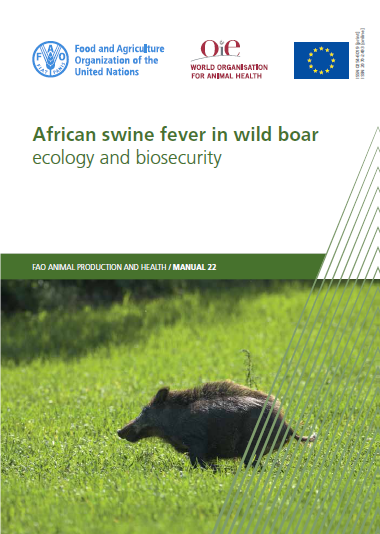
Many countries around the world are currently in the grip of an African swine fever (ASF) outbreak. ASF is a viral haemorrhagic disease causing up to 100% fatality in domestic and wild pigs, for which there is no effective vaccine or treatment. This disease does not infect humans but causes economic losses which threaten food and nutritional security, affect trade, and present a serious challenge for sustained pig production.
In Europe and Asia, wild boar has become an epidemiological reservoir of the virus, contracting, carrying and spreading African swine fever. The virus has taken advantage of the recent increase in density and distribution of the population. In this scenario, any domestic pig living in an area where there are infected wild boars is at risk of being infected.
A new publication from OIE, the Food and Agriculture Organization of the United Nations (FAO) and the European Commission (EC), aims to assist veterinary services, wildlife management authorities and institutions dealing with ASF prevention and control, including hunters, who are often a key part of the response when ASF is detected in wild boar populations. African Swine Fever in wild boar: Ecology and biosecurity, provides an overview of epidemiological features and ecology of African swine fever and shares recent experiences in prevention and control of ASF in wild boar in Europe.
This manual identifies two main pillars of ASF eradication for wild boar: preventing environmental virus contamination and implementing biosecurity during hunting, a relatively novel concept. The expertise which led to these strategies was gained through the experience of the international scientific community, while trying to control and eradicate ASF in wild boar populations during the last year. This was the first time that ASF had been detected in large populations of widely distributed wild boar. Originally, scientists recommended trying to tackle the outbreak using strategies which were effective for other infectious diseases. However, due to the abundance of wild boar and the unique ability of ASF to survive in frozen temperatures, carcasses and soil, it was soon evident that veterinary services and authorities dealing with ASF control in wild boar need new understanding and practices.
The management of ASF in wild boar must take account of the ecological relationship between four main components: the virus, the wild boar populations, wild boar management in the forests, and the wild boar / domestic pig interface. The manual recommends specific actions for various stages of an epidemic, in order to prevent counteractive measures such as total wild boar depopulation or winter feeding, the practice of supporting wild boar during months when resources are scarce. The manual also explains how it is possible to minimize the probability of virus spread while hunting in infected areas, and how to deal with wild boar carcasses that remain infected for months during winter, due to the hardiness of the virus.
This publication will contribute to development of technically sound, feasible and efficient ASF control strategies and actions in countries that face ASF in wild boar, or where it interferes in the eradication of the virus in domestic pigs.

